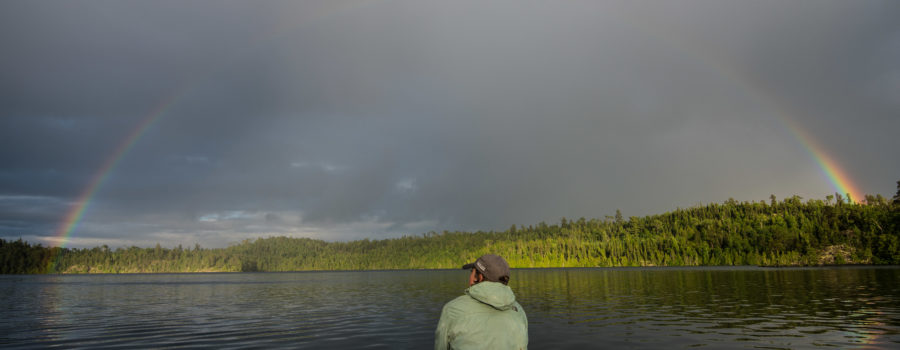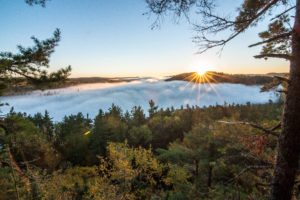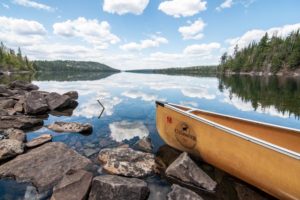I believe every place on earth has their own unique phrase “We have blank season, blank season and blank season.” Clearly it’s a pretty sardonic way of describing your environment but on the Gunflint Trail “We have Winter, mud season, and bug season”. For good reason this can be a huge component to any BWCA camping trip and we get phone calls about the bugs regularly asking about current conditions and how best to address their presence. I am going to do my best to answer both knowing that current conditions is always in flux and that if you’re in the woods in the summer there will be bugs of some kind. Mandatory Disclaimer: Everybody is affected by bugs differently and the way I prepare for and describe them is my own based on personal experience.
Let us start out with the fact that if you want to guarantee yourself a truly bug-free Boundary Waters experience you need to visit in January. Seriously though November through April is the only stretch I can confidently tell somebody they will not find bugs in the wilderness although most years I would include May as well. With that in mind everything else I have to say about bugs is what typically happens, with great variations in temperatures and moisture playing a huge role into how buggy your trip will be.
Most years will have people padding in bug free conditions until around Memorial Day when we get a first hatch of mosquitoes. I am by no means an entomologist but for whatever reason this first hatch seems like a trial run of prototype bugs; they are twice as large as typical mosquitoes, fly very slow, and don’t even bite. This annual siege of proboscis-less robo-skeeters is followed by roughly a week of bug free skies. This week always lulls us into a fantasy world and it typically ends around the time somebody notes that “Maybe the bugs won’t be so bad this year.” This asinine statement is followed by clouds of black flies that attack every orifice on your head and attempt the construction of sprawling subdivisions along every hairline not covered. These hoards make us long for our vegetarian mosquito friends from a couple of weeks ago, right up until their viciously carnivorous smaller brethren join the outbreak.
This pincer maneuver by both black fly and mosquito typically occurs in the middle of June and lasts for a week or so until the final member of the insect triumvirate makes their final hellish appearance. Personally I think I am affected by them more than most people but when the no-see-ums (midges, sand flies, or Ceratopogonidae as it were) make their ungodly presence known I have no problem spending my free time on the screen porch. Dealing with mosquitoes is no big deal, they are honestly more of an auditory nuisance, with their tiniest of wings making the highest of pitch whine around your ears, their slow speeds and very noticeable bite making for easy and satisfying slapping. Black flies have numbers on their side and the fact that they are constantly on a kamikaze mission for your mouth, eyes and ear holes is much more bothersome than their bite, though not painful it will itch for a day or so especially if its on a meaty part of your body. If the ant is the champion of lifting 100 times its weight the no-see-um is the champion of bringing pain 100 times its size. All of a sudden it will feel like somebody is extinguishing a tiny cigarette on your hand and you’ll look down and see nothing, but upon closer inspection a pin head size black dot is sitting right where the pain is coming from; seriously this thing is microscopic. After unsatisfyingly smearing the useless thing from your hand a violently itchy bump will rise from the ashes like some dystopian phoenix and continue to remind you of its death for 20-30 minutes. When the triumvirate is all in force it’s downright lousy to be in the woods, but fortunately they do not join forces for very long or very often. By early July they are all manageable and come out only around sunrise and sunset and by the end of the month they really only come out after the rain. Into August the presence of all three at the same time is very rare and the no-see-ums and black flies are pretty much done for the year. Mosquitoes can still be quite bothersome in August and September anytime after it rains followed by some sun, but fortunately those two months are drier than most and the cool nights in September will reduce their numbers until we get a couple of hard frosts.
At this point you’re probably asking yourself “Why the hell would anybody want to subject themselves to the hoards of bugs in the Northwoods?” The answer to that questions is honestly they’re not as bad as I made it sound. Throughout the day and on the water you will likely experience very few bugs at all, most of your concern will be on portages and at campsites, especially in the morning and evening. Even when they are bad there are things you can do to help the situation.
Loose fitting long sleeve pants and shirts is the best method to keep the vast majority of the bugs away and after covering up like that a little bit of DEET on the top of your hat will go a long way. The black flies are not as deterred by bug spray and a lot of people like to use head nets, but I personally find a head net more bothersome than the bugs themselves and will stoke up a nice smoky fire if they become an issue. The one thing I see and smell people doing that is not helping their cause is showering and applying fragrant deodorants and perfumes the morning of their trip into the BWCA. During the days leading up to your trip a decrease in the number of showers and an increase in the intake of garlic would be your best way to prepare, but I know that won’t fly with most people.
These are just my thoughts on the matter and even when the bugs are at their worst they still don’t out weigh all of the amazing things that come with exploring and spending the night in Boundary Waters Canoe Area Wilderness.




Leave a Reply
Your email is safe with us.
You must be logged in to post a comment.